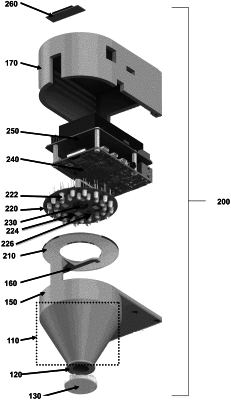| CPC A61B 5/02055 (2013.01) [A61B 5/0022 (2013.01); A61B 5/0261 (2013.01); A61B 5/0537 (2013.01); A61B 5/14551 (2013.01); A61B 5/447 (2013.01); A61B 5/4842 (2013.01); A61B 5/6843 (2013.01); A61B 5/7275 (2013.01); G16H 10/60 (2018.01); A61B 5/01 (2013.01); A61B 5/721 (2013.01); A61B 2090/0813 (2016.02); A61B 2560/0223 (2013.01); A61B 2560/0252 (2013.01); A61B 2562/0219 (2013.01); A61B 2562/0247 (2013.01); A61B 2562/166 (2013.01)] | 11 Claims |

|
1. A medical device for measuring tissue properties in a subject, comprising:
a light-guiding cone comprising an opaque, anti-reflective, sloped surface and having optical properties that direct light along an optical excitation path into a homogeneous field on a tissue of interest in the subject;
a plurality of excitation light sources disposed at an open end of the light-guiding cone, each of said plurality emitting light at a wavelength from visible to near infrared;
an image sensor configured to measure intensities of light with different wavelengths reflected from the tissue of interest;
a radially extruded lip at the end of the light-guiding cone disposed to cover an area of the tissue of interest under interrogation and to prevent ambient light from impinging on the area;
at least one pressure sensor configured to sense conformal attachment of the medical device to the surface of the tissue of interest;
and
a processor and a memory in electronic communication with the device and tangibly storing an algorithm for processing the reflected wavelengths as a measurement of tissue properties, said algorithm comprising processor-executable instructions that perform all of the following to:
predict an Ankle Brachial Index from measurements of tissue oxygenation, tissue temperature, or perfusion index or a combination thereof at at least one wavelength;
correlate tissue oxygenation measurements from an upper limb and a lower limb of the subject to the Ankle Brachial Index;
measure a photoplethysmography signal; and
predict peripheral artery disease in the subject.
|